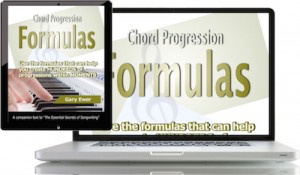In good songs, there is a sense of connection — or perhaps communication, in a way — between its various sections. You hear the chorus, and it sounds like the logical follower for what the verse offered.
So how do we ensure that each section of a song feels connected to what came before it?
 Ever wonder how to make the chords-first songwriting process work well for you? If all you seem to come up with is a bunch of chords but little else, you need to read “Writing a Song From a Chord Progression” Get it separately, or as part of “The Essential Secrets of Songwriting” 10-eBook Bundle.
Ever wonder how to make the chords-first songwriting process work well for you? If all you seem to come up with is a bunch of chords but little else, you need to read “Writing a Song From a Chord Progression” Get it separately, or as part of “The Essential Secrets of Songwriting” 10-eBook Bundle.
Because several different elements work together in songs (lyrics, chords, melodies, instrumentation, rhythm, etc.), smoothing out the connections between song sections means looking at each one of those elements separately.
As I say, it’s probably more an issue of communication than it is of connection. There are some songs for which the melody of the chorus bears little resemblance to what came before it in the verse. And yet the connection is there, because it sounds like the chorus is responding to the musical ideas of the verse.
So let’s look at how you can ensure that you’ve got a song for which the many sections are displaying this important sense of communication. If you’re working on a song now, or if you’ve just finished one, sing whatever you’ve got to yourself a couple of times, and then look through the following list of ideas:
Lyrics
I like the concept of the logical follower when describing good lyrics. So often, songwriters try to be imaginative and unique with their lyrics, but they end up writing gobbledygook – lyrics that just don’t make sense, one line to the next.
And then when they reach the chorus, it seems that nothing is responding to whatever the verse has been trying to say.
So here are a couple of things to try:
- Point to your first line of lyric and then look at the second line. Is the second line a logical follower? Can you say, “Because I wrote this line, I then wrote that line,” and have it make sense that way? Good lyrics will have moments of complete direction change, but the connection always seems to be there. (For practice, read through Bono’s “Running To Stand Still” and say, “Because he wrote this line, he then wrote that line.” Sometimes you just have to take the time to see those connections.
- Now look at the last two lines of your verse, and the first two lines of your chorus. Is the chorus responding to situations, people or circumstances described in the chorus? A great tune to practice this Flo Rida’s “My House” (Ross Golan, Johan Carlsson, Marco Borrero, Roy Hammond, Tramar Dillard):
…
Yeah, you know what we is
Sometimes you gotta stay in, inWelcome to my house
Baby take control now…
…
Melodies
It’s nice when you hear the ideas of the verse becoming a catchy hook in the chorus. I find myself using McCartney’s “Penny Lane” as a great example for almost anything and everything, and this idea of spinning a verse melody into something amazingly catchy for the chorus is demonstrated so well with that tune.
In “Penny Lane”, you hear that opening rising melodic scale on the words “Penny Lane”, and it keeps happening, sometimes exactly as the first line, sometimes starting on a new pitch: “Of every head…”, “all the people…” “stop and say hello.” When you finally get to the chorus, the melody suddenly becomes this catchy, relentless hook: “Penny Lane is in my ears and in my eyes/ There beneath the blue suburban skies…”
But the truth is that you don’t need to use your verse melody ideas in your chorus at all, in order for the connection to be there. The main part of the chorus for “Moves Like Jagger“, which uses mainly upward-moving ideas for the verse, and downward-moving ones for the chorus, works so well because it ends with a melodic idea from the intro hook.
To make good melodic connections, then, opposites can often work well. You hear this same opposite direction idea in John Lennon’s “Imagine.”
Chords
To make good connections between the verse and chorus chords, approach it the way you’d approach lyrics: look at the last 2 or 3 chords of the verse, and then play the first 2 or 3 chords of the chorus. What are you’re looking for when you do this?
- The way the last chord of the verse connects to the first chorus is going to be crucial. The easiest relationship for audiences is the dominant-tonic relationship: for songs in C major, ending the verse on a V-chord (G or G7) will move easiest to the chorus if it starts on the tonic chord (C).
- Explore beyond tonic-dominant. Ending the verse on V, then starting the verse on IV is a great way to generate musical momentum (“Imagine”). But consider some other possibilities: I-V, V-vi, V-ii, and so on.
In this post I’ve only been talking about verse-chorus relationships, but there needs to be smooth connections all throughout a song, and the same guidelines will apply, including connections between the chorus back to the verse.
Take the time to play the one or two bars that end one section, and then the one or two that start the next one, and then put the magnifying glass on each separate component as we’ve done in this post.
The time you take to do that will be well worth it!
 Written by Gary Ewer. Follow Gary on Twitter
Written by Gary Ewer. Follow Gary on Twitter
 “Chord Progression Formulas” shows you a system for creating your own progressions in seconds using some basic formulas, in both major or minor keys. It’s available at the Online Store.
“Chord Progression Formulas” shows you a system for creating your own progressions in seconds using some basic formulas, in both major or minor keys. It’s available at the Online Store.











Again, would be great to hear examples of songs doing it wrong. I know it would probably be considered unprofessional but it would be insightful.
The chorus is basically a a Summary of what has gone in the verses
Sometimes it’s nothing more that a short refrain repeated several times
Cant Buy Me Love Ticket To Ride Keep your chorus short and try to
use a chord or two that is not any where else in the song, also use
Long Notes as preferred to too many short ones , Keep it Catchy
and easy to sing